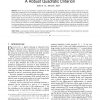Free Online Productivity Tools
i2Speak
i2Symbol
i2OCR
iTex2Img
iWeb2Print
iWeb2Shot
i2Type
iPdf2Split
iPdf2Merge
i2Bopomofo
i2Arabic
i2Style
i2Image
i2PDF
iLatex2Rtf
Sci2ools
PAMI
2012
2012
Angular Embedding: A Robust Quadratic Criterion
Abstract—Given the size and confidence of pairwise local orderings, angular embedding (AE) finds a global ordering with a nearglobal optimal eigensolution. As a quadratic criterion in the complex domain, AE is remarkably robust to outliers, unlike its real domain counterpart LS, the least squares embedding. Our comparative study of LS and AE reveals that AE’s robustness is due not to the particular choice of the criterion, but to the choice of representation in the complex domain. When the embedding is encoded in the angular space, we not only have a non-convex error function that delivers robustness, but also have a Hermitian graph Laplacian that completely determines the optimum and delivers efficiency. The high quality of embedding by AE in the presence of outliers can hardly be matched by LS, its corresponding L1 norm formulation, or their bounded versions. These results suggest that the key to overcoming outliers lies not with additionally imposing constraints on the embedd...
| Added | 28 Sep 2012 |
| Updated | 28 Sep 2012 |
| Type | Journal |
| Year | 2012 |
| Where | PAMI |
| Authors | Stella Yu |
Comments (0)

